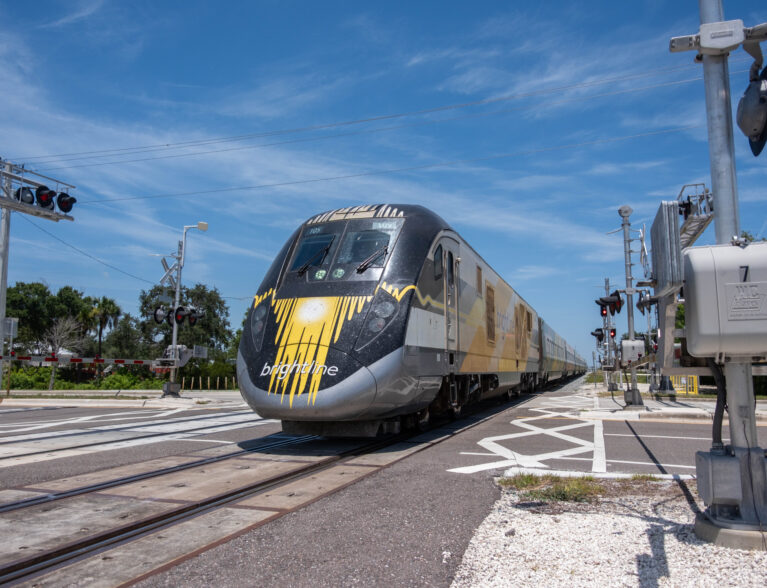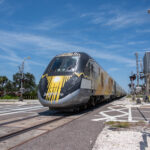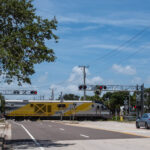
It has been almost two years since Brightline’s sleek, brightly colored trains began flashing through Vero Beach, and the apocalypse Indian River County warned against in its unsuccessful multimillion-dollar fight to block the train has not materialized.
There’s been no pedestrian slaughter, no patients dying in stranded ambulances, and not even the forecasted lengthy traffic backups.
While there have been four deaths and a handful of injuries along the tracks since the train began passing through Indian River County, waiting at a crossing for a Brightline train as it races back and forth between Orlando and Miami is more like waiting for a red light to change than settling in for the excruciatingly slow passage of a long Florida East Coast Railway freight.
Which is not to say the train company, which is owned by Fortress Investment Group, has outrun its legacy of controversy and doubt.
Its story remains very much a tale of two trains. On one hand, the company has managed against the odds to create a high-tech, high-speed commuter rail line along a major transportation corridor that transports millions of people a year who often give it good reviews.
On the other, Brightline’s finances appear ever more dire and the death toll along the South Florida stretch of its 235-mile route continues to grow.
The trains are getting longer, expanding from four to five to six passenger cars since Orlando service launched in September 2023, with plans to add a seventh car this fall to accommodate growing ridership. Yet, the company lost more than half a billion dollars in 2024.
A burst of Brightline news in July highlighted the company’s split personality. On the plus side, the rail line reported a 22 percent increase in riders on the South Florida to Orlando route and a 12 percent jump in revenue in the first half of the year.
At the same time, Brightline failed to pay interest on $1.2 billion in bonds and saw much of its debt downgraded to “junk” status by S&P Global Ratings. That came on top of bond downgrades from Fitch and other rating agencies earlier in the year.
Also in July, the Miami Herald and Miami PBS station WLRN published a long, gritty article entitled “Killer Train,” that identified Brightline as “the deadliest major passenger railroad in the United States … killing someone every 13 days of service on average,” including 49 people last year.
The company has not been found at fault for any of the deaths, but it is defending itself against multiple lawsuits and has settled some for undisclosed amounts, according to court records cited by the Miami Herald.
Brightline has also been harshly criticized for blaming victims. The railroad has claimed that a majority of the deaths were suicides. Reporters found that only 40 percent of fatalities had been ruled as suicides, 75 out of 182.
The train company has blamed other deaths on drug use and intoxication, which has been true in some instances, but victims have also included people wearing headphones, people who tripped on the tracks in the dark, and Randy Johanson, a deaf man who was struck and killed last year in Micco in Brevard County by a Brightline train he did not hear coming.
Brightline nevertheless appears to have staunch support from city, county and state officials for its plans to expand service from Orlando to Tampa.
In mid-July, “City of Tampa officials voted unanimously to allow Brightline to move forward with the financing process . . . and Mayor Jane Castor suggested a downtown Tampa station could launch by 2029,” according to Tampa Bay Times.
Also on the plus side, the company has created a partnership with JetBlue, which operates out of numerous Florida airports, so that passengers can book flights and train rides at the same time.
It’s also integrating its reservation system with travel technology company Amadeus, which will allow hundreds of travel agents and tour operators to put people on Brightline trains.
But the company’s financial situation looks grim.
Brightline Florida is carrying about $5 billion in debt with just $188 million in revenue last year. That was double the prior year’s revenue due to growing Orlando ridership, but did not come close to meeting expenses.
The Palm Beach Post reported in May that the company lost a whopping $549 million in 2024.
“Brightline spent $341 million running and maintaining its trains and stations in 2024, bringing in about $188 million from ticket sales and other sources, for a deficit of more than $153 million,” according to the Post.
In addition, Brightline “paid $178 million in interest on its debt,” and another $218 million to refinance debt.
Brightline’s bonds are expensive to carry, paying as much as 12 percent in interest, and when the company deferred interest payments on $1.2 billion in unsecured IOUs in July, it dug the hole deeper.
Under the terms of the bond agreement, the company is allowed to defer payments but must pay an additional 2 percent in interest on the bonds going forward.
Attempting to find a way out, Brightline is looking to sell “equity in the train service to outside investors,” according to Miami radio station WLRN.
“How much of the company it is looking to sell, at what price and to whom isn’t known … but Brightline said it ‘continues to actively progress the planned issuance of a substantial amount of equity, with a global process underway engaging with numerous potential strategic partners,’” according to WLRN.
“Money raised by any equity sale would be used to repay higher interest rate bonds and build cash reserves.”
In addition, the company has asked the Florida Development Finance Corporation for permission to issue another $400 million dollars in IOUs in the form of private activity bonds, according to multiple reports.
That money would be used to pay for stations in Stuart and Cocoa and help fund the Tampa extension.
Even if Brightline is able to issue $400 million in new bonds and manages to sell them despite its growing financial woes, the bonds would have to carry a problematic interest rate to attract investors and would not amount to a long-term solution for a company losing money at Brightline’s clip.
Even without the onetime $218 million refinance charge, the company lost $330 million last year, a flow of red ink that could quickly consume the new bond proceeds.
Brightline was founded as All Aboard Florida in 2012 and went through several changes in ownership before completing its 235-mile route in September 2023.
The company operates 16 trains daily in both directions, hitting speeds of 125 miles an hour. They currently have an engine at each end and six passenger cars, including one first class car.
The trains are designed to eventually have 10 passenger cars and two engines if ridership continues to grow, according to Brightline media relations director Ashley Blasewitz.
Photos by Joshua Kodis





